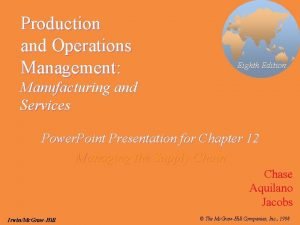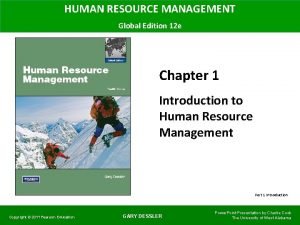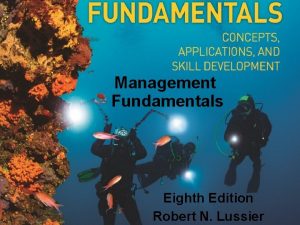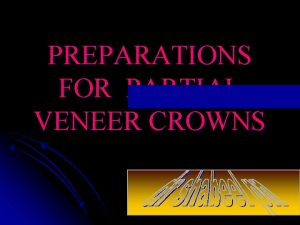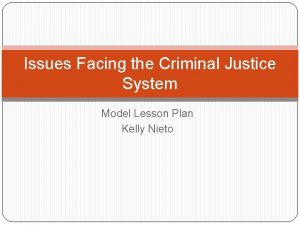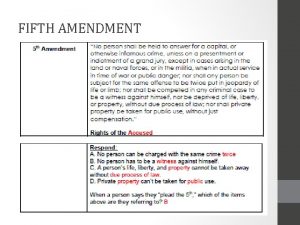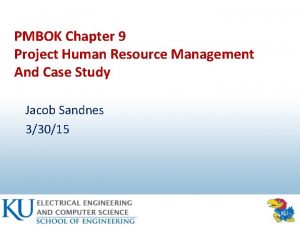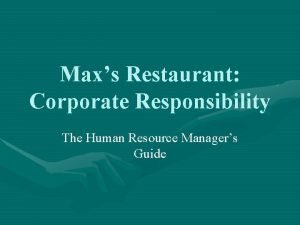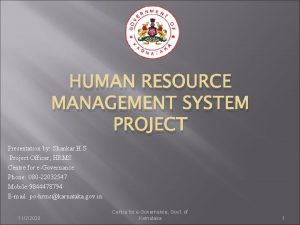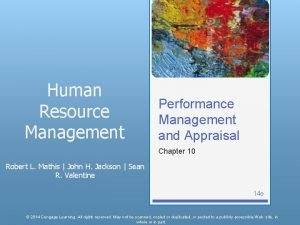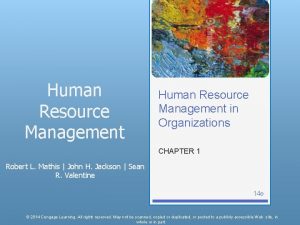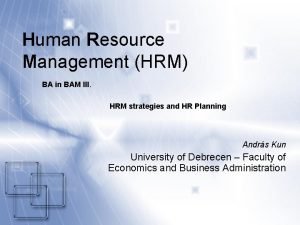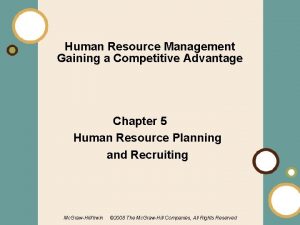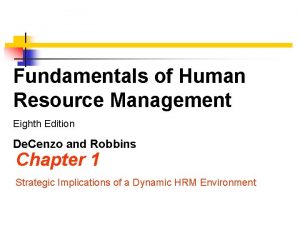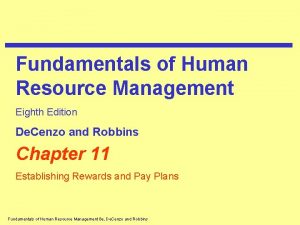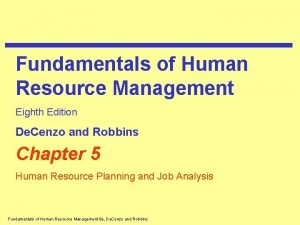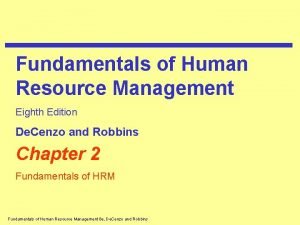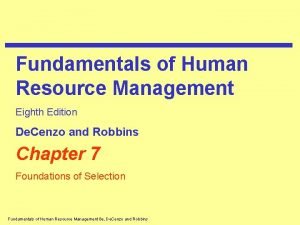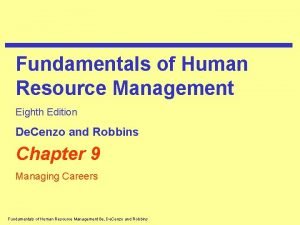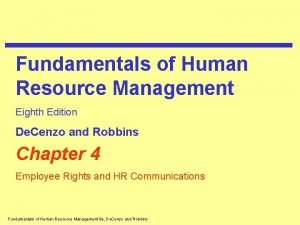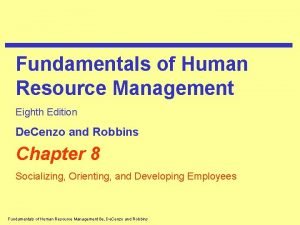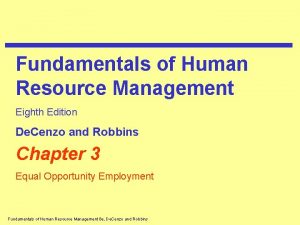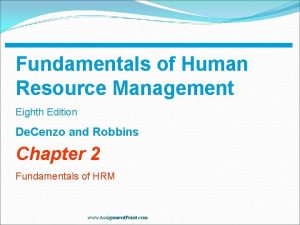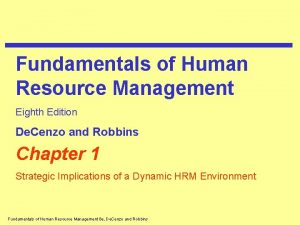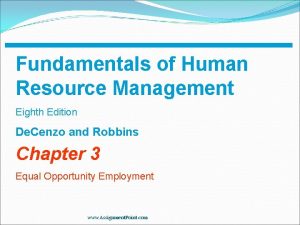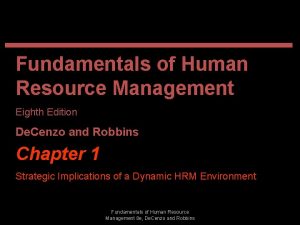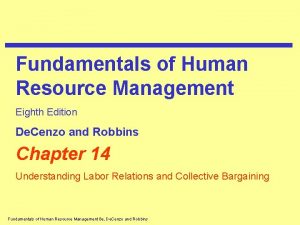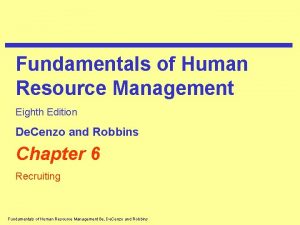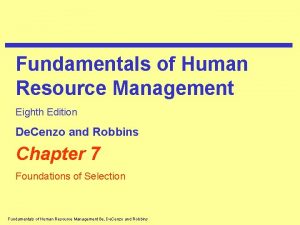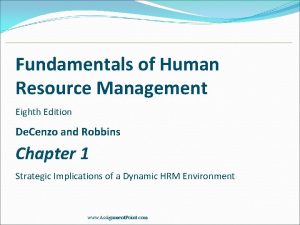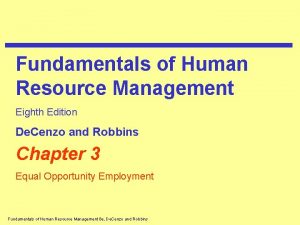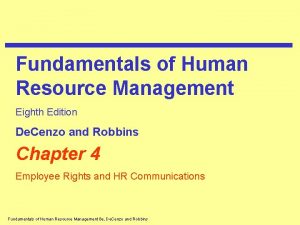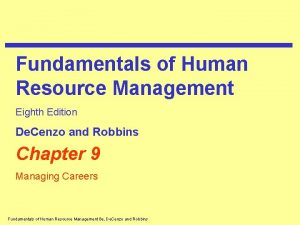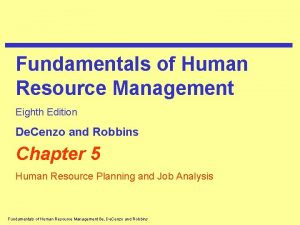Fundamentals of Human Resource Management Eighth Edition De




































- Slides: 36

Fundamentals of Human Resource Management Eighth Edition De. Cenzo and Robbins Chapter 10 Establishing the Performance Management System Fundamentals of Human Resource Management 8 e, De. Cenzo and Robbins

Introduction • Employees generally see performance evaluations as having a direct effect on their work lives. • The performance management systems need to include: – decisions about who should evaluate performance – what format should be used – how the results should be utilized Fundamentals of Human Resource Management 8 e, De. Cenzo and Robbins

Performance Management Systems Purposes of a Performance Management System – Feedback - let employees know how well they have done and allow for employee input. – Development – identify areas in which employees have deficiencies or weaknesses. – Documentation - to meet legal requirements. Fundamentals of Human Resource Management 8 e, De. Cenzo and Robbins

Performance Management Systems Difficulties in Performance Management Systems – Focus on the individual: Discussions of performance may elicit strong emotions and may generate conflicts when subordinates and supervisors do not agree. Fundamentals of Human Resource Management 8 e, De. Cenzo and Robbins

Performance Management Systems Difficulties in Performance Management Systems – Focus on the process: Company policies and procedures may present barriers to a properly functioning appraisal process. – Additionally, appraisers may be poorly trained. Fundamentals of Human Resource Management 8 e, De. Cenzo and Robbins

Performance Management and EEO • HRM practices must be bias free, objective and job-related. • Valid performance appraisals are conducted at established intervals and are done by trained appraisers. Fundamentals of Human Resource Management 8 e, De. Cenzo and Robbins

The Appraisal Process 7. Appeal if not satisfied Fundamentals of Human Resource Management 8 e, De. Cenzo and Robbins

The Appraisal Process • Establishment of performance standards – Derived from company’s strategic goals. – Based on job analysis and job description. • Communication of performance standards to employee. Fundamentals of Human Resource Management 8 e, De. Cenzo and Robbins

The Appraisal Process • Measurement of performance using information from: – personal observation – statistical reports – oral reports – written reports • Comparison of actual performance with standards. Fundamentals of Human Resource Management 8 e, De. Cenzo and Robbins

The Appraisal Process • Discussion of appraisal with employee. • Identification of corrective action where necessary. – Immediate action deals with symptoms. – Basic corrective action deals with causes. Fundamentals of Human Resource Management 8 e, De. Cenzo and Robbins

Appraisal Methods Three approaches: • Absolute standards • Relative standards • Objectives Fundamentals of Human Resource Management 8 e, De. Cenzo and Robbins

Appraisal Methods Evaluating absolute standards: • An employee’s performance is measured against established standards. • Evaluation is independent of any other employee. Fundamentals of Human Resource Management 8 e, De. Cenzo and Robbins

Appraisal Methods Evaluating absolute standards: – Essay Appraisal: Appraiser writes narrative describing employee performance & suggestions. – Critical Incident Appraisal: Based on key behavior anecdotes illustrating effective or ineffective job performance. Fundamentals of Human Resource Management 8 e, De. Cenzo and Robbins

Appraisal Methods Evaluating absolute standards: – Checklist Appraisal: Appraiser checks off behaviors that apply to the employee. – Adjective Rating Scale Appraisal: Appraiser rates employee on a number of job-related factors. Fundamentals of Human Resource Management 8 e, De. Cenzo and Robbins

Appraisal Methods Evaluating absolute standards: – Forced-Choice Appraisal: Appraisers choose from sets of statements which appear to be equally favorable, the statement which best describes the employee. Fundamentals of Human Resource Management 8 e, De. Cenzo and Robbins

Appraisal Methods Evaluating absolute standards: • Behaviorally Anchored Rating Scales (BARS): Appraiser rates employee on factors which are defined by behavioral descriptions illustrating various dimensions along each rating scale. Fundamentals of Human Resource Management 8 e, De. Cenzo and Robbins

Appraisal Methods Relative standards: • Employees are evaluated by comparing their performance to the performance of other employees. Fundamentals of Human Resource Management 8 e, De. Cenzo and Robbins

Appraisal Methods Relative standards: • Group Order Ranking: Employees are placed in a classification reflecting their relative performance, such as “top onefifth. ” Fundamentals of Human Resource Management 8 e, De. Cenzo and Robbins

Appraisal Methods Relative standards: – Individual Ranking: Employees are ranked from highest to lowest. – Paired Comparison: • Each individual is compared to every other. • Final ranking is based on number of times the individual is preferred member in a pair. Fundamentals of Human Resource Management 8 e, De. Cenzo and Robbins

Appraisal Methods Using Achieved Outcomes to Evaluate Employees Management by Objectives (MBO) – includes mutual objective setting and evaluation based on the attainment of the specific objectives Fundamentals of Human Resource Management 8 e, De. Cenzo and Robbins

Appraisal Methods Using Achieved Outcomes to Evaluate Employees – Common elements in an MBO program are: • • goal specificity participative decision making an explicit time period performance feedback – Effectively increases employee performance and organizational productivity. Fundamentals of Human Resource Management 8 e, De. Cenzo and Robbins

Factors that can Distort Appraisals Fundamentals of Human Resource Management 8 e, De. Cenzo and Robbins

Factors that can Distort Appraisals • Leniency error – Each evaluator has his/her own value system. – Some evaluate high (positive leniency) and others, low (negative leniency). • Halo error: Evaluator lets an assessment of an individual on one trait influence evaluation on all traits. Fundamentals of Human Resource Management 8 e, De. Cenzo and Robbins

Factors that can Distort Appraisals • Similarity error: Evaluator rates others in the same way that the evaluator perceives him or herself. • Low appraiser motivation: Evaluators may be unwilling to be accurate if important rewards for the employee depend on the results. Fundamentals of Human Resource Management 8 e, De. Cenzo and Robbins

Factors that can Distort Appraisals • Central tendency: The unwillingness to use the extremes of a rating scale and to adequately distinguish among employees being rated. • Inflationary pressures: Pressures for equality and fear of retribution for low ratings leads to less differentiation among rated employees. • Inappropriate substitutes for performance: Effort, enthusiasm, appearance, etc. are less relevant for some jobs than others. Fundamentals of Human Resource Management 8 e, De. Cenzo and Robbins

Factors that can Distort Appraisals Attribution Theory • Evaluations are affected based on whether someone’s performance is due to – internal factors they can control – external factors which they cannot • If poor performance is attributed to internal control, the judgment is harsher than when it is attributed to external control. Fundamentals of Human Resource Management 8 e, De. Cenzo and Robbins

Factors that can Distort Appraisals • Impression management: • If employee positively influences the relationship with the supervisor, he/she is likely to receive a higher rating. Fundamentals of Human Resource Management 8 e, De. Cenzo and Robbins

Creating More Effective Performance Management Systems Use Behavior-Based Measures: • Measures based on specific descriptions of behavior are more jobrelated and elicit more inter-rater agreement than characters, such as “loyalty” or “friendliness”. Fundamentals of Human Resource Management 8 e, De. Cenzo and Robbins

Creating More Effective Performance Management Systems Combine Absolute and Relative Standards: • Absolute standards tend to be positively lenient; relative standards suffer when there is little variability. • Combining the standards tends to offset the weaknesses of each. Fundamentals of Human Resource Management 8 e, De. Cenzo and Robbins

Creating More Effective Performance Management Systems Provide Ongoing Feedback: • Expectations and disappointments should be shared with employees on a frequent basis. Fundamentals of Human Resource Management 8 e, De. Cenzo and Robbins

Creating More Effective Performance Management Systems Use Multiple Raters: • Increasing the number of raters leads to more reliable and valid ratings. – Use peer evaluations: Coworkers offer constructive insights and more specific evaluations. – Upward appraisals allow employees to give their managers feedback. – 360 -Degree appraisals: Supervisors, peers, employees, team members, customers and others with relevant information evaluate the employee. Fundamentals of Human Resource Management 8 e, De. Cenzo and Robbins

Creating More Effective Performance Management Systems Rate Selectively – Appraisers only evaluate in those areas about which they have sufficient knowledge. – Appraisers should be organizationally as close as possible to the individual being evaluated. – More effective raters are asked to do the appraisals. Fundamentals of Human Resource Management 8 e, De. Cenzo and Robbins

Creating More Effective Performance Management Systems Train Appraisers: • Untrained appraisers who do poor appraisals can demoralize employees and increase legal liabilities. Fundamentals of Human Resource Management 8 e, De. Cenzo and Robbins

Creating More Effective Performance Management Systems Fundamentals of Human Resource Management 8 e, De. Cenzo and Robbins

International Performance Appraisal • Who performs the evaluation? – Different cultural perspectives and expectations between the parent and local country make evaluation difficult. – Evaluation forms may not be translated accurately. – Quantitative measures may be misleading. Fundamentals of Human Resource Management 8 e, De. Cenzo and Robbins

International Performance Appraisal • Evaluation Formats – May make sense to use different forms for parent-country nationals and host-country nationals. – Performance criteria for a particular position should be modified to fit the overseas position and site. – Include a current expatriate’s insights as part of the evaluation. Fundamentals of Human Resource Management 8 e, De. Cenzo and Robbins
 Operations management eighth edition
Operations management eighth edition Psychology eighth edition david g myers
Psychology eighth edition david g myers Psychology
Psychology Human resource management 15th edition
Human resource management 15th edition Line and staff aspects of hrm
Line and staff aspects of hrm International human resource management dowling 6th edition
International human resource management dowling 6th edition Management fifteenth edition
Management fifteenth edition Workforce and demographic trends in hrm
Workforce and demographic trends in hrm Time management human resources
Time management human resources Human resources in retail management process consists of
Human resources in retail management process consists of Management vs human resource management
Management vs human resource management Management fundamentals 8th edition
Management fundamentals 8th edition Anagram of eighth
Anagram of eighth Matching planet rings
Matching planet rings Nearest eighth of an inch
Nearest eighth of an inch The fifth, sixth, seventh, and eighth amendments protect *
The fifth, sixth, seventh, and eighth amendments protect * 8th commandment catholic
8th commandment catholic Taj mahal wonder of the world
Taj mahal wonder of the world Partial veener crown
Partial veener crown Eighth amendment excessive bail
Eighth amendment excessive bail Eighth letter of the alphabet
Eighth letter of the alphabet Eighth amendment excessive bail
Eighth amendment excessive bail 8 amendment
8 amendment Project human resource management pmbok ppt
Project human resource management pmbok ppt Pmbok human resource management
Pmbok human resource management Importance of hr management
Importance of hr management Human resource management in restaurants
Human resource management in restaurants Human resource planning and retention
Human resource planning and retention Hrm chapter 2
Hrm chapter 2 Chapter 9 human resources management
Chapter 9 human resources management Human resource management system project ppt
Human resource management system project ppt Mbo performance appraisal method
Mbo performance appraisal method Current issues in human resource management
Current issues in human resource management Ba human resource management
Ba human resource management Employer employee relationship in hrm
Employer employee relationship in hrm Human resources management gaining a competitive advantage
Human resources management gaining a competitive advantage Human resource management gaining a competitive advantage
Human resource management gaining a competitive advantage
